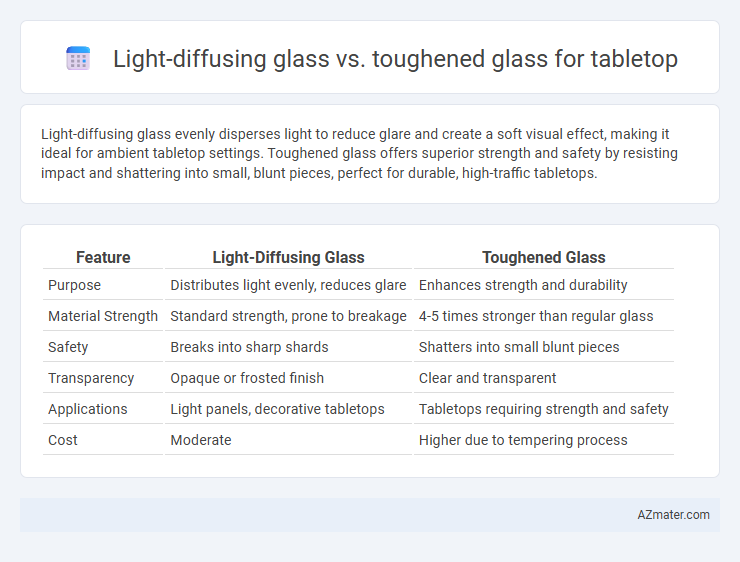Light-diffusing glass evenly disperses light to reduce glare and create a soft visual effect, making it ideal for ambient tabletop settings. Toughened glass offers superior strength and safety by resisting impact and shattering into small, blunt pieces, perfect for durable, high-traffic tabletops.
Table of Comparison
| Feature | Light-Diffusing Glass | Toughened Glass |
|---|---|---|
| Purpose | Distributes light evenly, reduces glare | Enhances strength and durability |
| Material Strength | Standard strength, prone to breakage | 4-5 times stronger than regular glass |
| Safety | Breaks into sharp shards | Shatters into small blunt pieces |
| Transparency | Opaque or frosted finish | Clear and transparent |
| Applications | Light panels, decorative tabletops | Tabletops requiring strength and safety |
| Cost | Moderate | Higher due to tempering process |
Introduction to Tabletop Glass Options
Light-diffusing glass for tabletops offers a unique aesthetic by scattering light to create a soft, luminous surface that enhances ambient lighting and reduces glare. Toughened glass, also known as tempered glass, provides superior strength and safety, making it resistant to impact, thermal stress, and shattering into sharp pieces. Choosing between light-diffusing and toughened glass depends on whether the priority is on visual ambiance or durability and safety in tabletop design.
What is Light-Diffusing Glass?
Light-diffusing glass is designed to scatter light evenly across its surface, reducing glare and creating a soft, uniform illumination ideal for tabletops in both residential and commercial settings. This type of glass enhances visual comfort by minimizing harsh reflections and distributing natural or artificial light smoothly, making it a popular choice for modern interior design. In contrast, toughened glass is heat-treated to increase strength and safety but does not offer light diffusion properties, focusing instead on durability and shatter resistance.
Key Features of Toughened Glass
Toughened glass for tabletops is characterized by its high strength and enhanced safety features, being up to five times stronger than regular glass due to the thermal tempering process. It offers superior resistance to impact, heat, and thermal stress, making it ideal for households with children and high-traffic areas. Unlike light-diffusing glass, which focuses on softening and dispersing light, toughened glass prioritizes durability and shatter resistance, ensuring the tabletop remains intact under heavy use.
Visual Aesthetics: Light-Diffusing vs Toughened Glass
Light-diffusing glass enhances visual aesthetics by scattering light evenly, creating a soft, glowing effect that reduces glare and highlights the tabletop's design nuances. Toughened glass offers a clear, crisp appearance with sharp reflections and high transparency, emphasizing sleek modernity while ensuring durability. Choosing between these depends on preference for ambient, diffused lighting versus a polished, reflective surface that complements minimalist interiors.
Strength and Durability Comparison
Light-diffusing glass enhances aesthetics by evenly scattering light but generally has lower impact resistance compared to toughened glass, making it less suitable for high-stress tabletop applications. Toughened glass undergoes thermal or chemical treatment, increasing its strength up to five times that of standard glass, and offering superior durability against shocks, scratches, and thermal variations. For tabletops requiring maximum strength and long-lasting performance, toughened glass provides a more reliable and safer option than light-diffusing glass.
Light Transmission and Ambiance Effects
Light-diffusing glass for tabletops scatters light evenly, creating a soft, ambient glow that minimizes glare and enhances privacy while maintaining moderate light transmission around 60-70%. Toughened glass provides higher clear light transmission, typically 90% or more, resulting in a bright, sharp reflection that preserves visual clarity but offers minimal diffusion and ambiance modulation. Choosing light-diffusing glass improves mood and aesthetics with diffused illumination, whereas toughened glass prioritizes durability and clarity without altering the light environment significantly.
Safety Considerations for Tabletop Use
Light-diffusing glass enhances safety for tabletops by minimizing glare and concealment of fingerprints or smudges, reducing visual strain and slipping hazards. Toughened glass offers superior strength and shatters into small, blunt pieces, significantly lowering injury risk compared to regular glass under impact. Choosing between these types depends on balancing aesthetic diffusion benefits with maximum breakage safety.
Maintenance and Cleaning Requirements
Light-diffusing glass for tabletops requires gentle cleaning with non-abrasive, pH-neutral solutions to preserve its optical properties and prevent surface scratches. Toughened glass offers higher durability and resistance to impact, making it easier to maintain with regular wiping of standard glass cleaners without fear of damage. Both glasses benefit from microfiber cloths, but light-diffusing glass demands more careful handling to avoid deterioration of its diffusing effect over time.
Cost Comparison: Light-Diffusing vs Toughened Glass
Light-diffusing glass typically costs 20-30% more than toughened glass due to its specialized coating and manufacturing process that enhances light dispersion. Toughened glass remains the more budget-friendly option, valued for its durability and safety features in high-traffic areas. Cost efficiency depends on the functional priority: light-diffusing glass for aesthetic illumination versus toughened glass for strength and affordability in tabletops.
Choosing the Best Glass for Your Tabletop
Light-diffusing glass enhances ambient lighting and reduces glare, making it ideal for modern tabletops that prioritize aesthetic softness and visual comfort. Toughened glass offers superior strength and safety, resisting impact and thermal stress, which makes it the best choice for high-traffic or family environments where durability is essential. Selecting between light-diffusing and toughened glass depends on balancing the need for decorative effects with functional resilience in your tabletop design.

Infographic: Light-diffusing glass vs Toughened glass for Tabletop
 azmater.com
azmater.com